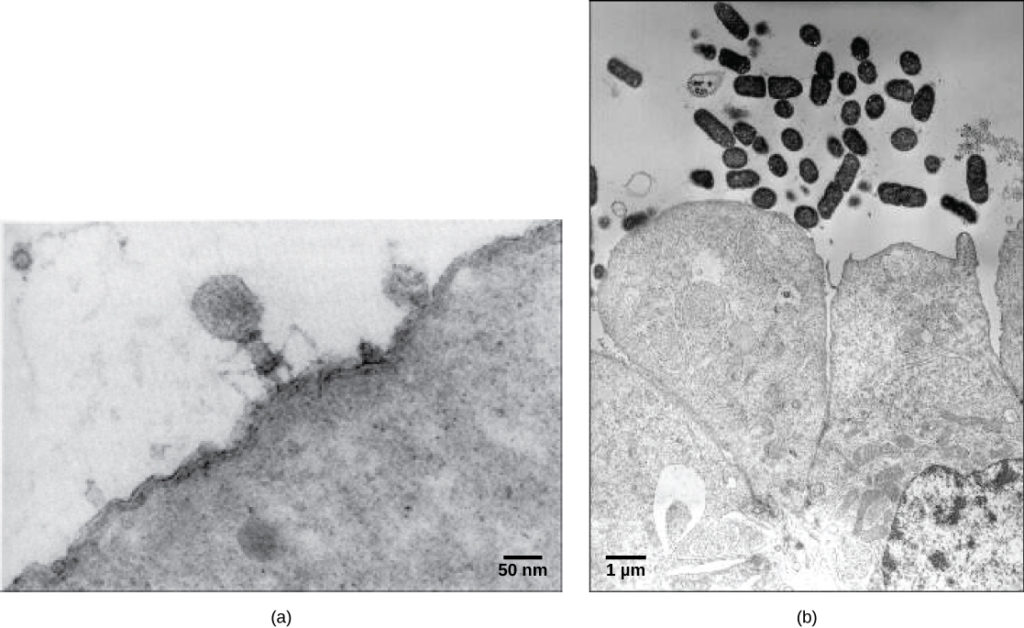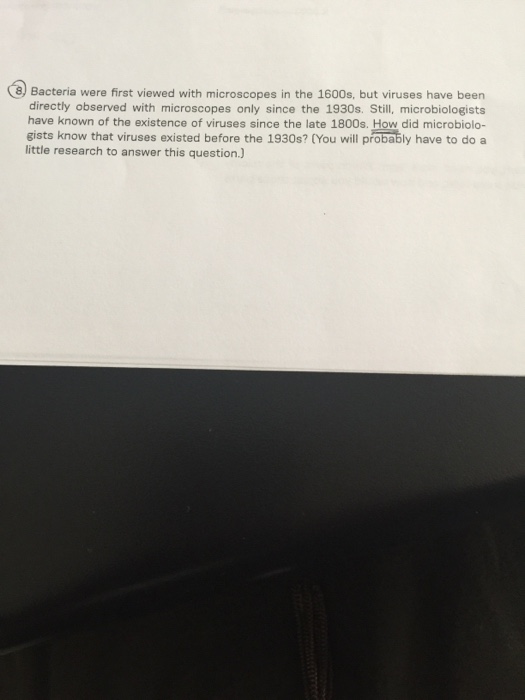How Did Microbiologists Know That Viruses Existed Before the 1930s
Scientists did not actually see viruses for the first time until the 1930s. The history of virology the scientific study of viruses and the infections they cause began in the closing years of the 19th century.
7 10 Discovery And Origin Of Viruses Biology Libretexts
But viruses have been directly observed with microscopes only since the 1930s.

. In 1915 English bacteriologist Frederick Twort discovered bacteriophage the viruses that attack bacteria. By the 1890s most communicable diseases were assumed to be caused by bacteria and establishing causality required culturing them on artificial media. If bacteria caused infection the filtered tissues should no longer be able to make other organisms sick.
Microbiology was born in 1674 when Antoni van Leeuwenhoek 1632 1723 a Dutch drapery merchant peered at a drop of lake water through a carefully ground glass lens. The tobacco mosaic virus shown in the Figure below was the first one to be seen. Alexander Fleming was it seems a bit disorderly in his work and accidentally discovered penicillin.
However it took over a decade before penicillin was introduced as a treatment for bacterial infections. Still microbiologists have known of the existence of viruses since the late 1800s. In 1915 English bacteriologist Frederick Twort discovered bacteriophage the viruses that attack bacteria.
The first evidence of the existence of viruses came from experiments with filters that had pores small. The word antibiotics was first used over 30 years later by the Ukrainian-American inventor and microbiologist Selman Waksman who in his lifetime discovered over 20 antibiotics. M13 did help unlock secrets of viral replication.
Before that time the word virus had for many decades been used non-specifically to describe a hypothetical communicable agent without denoting any particular size morphology or physical characteristics. Thats when the electron microscope was invented. The virus particle attaches to the host cell before penetrating it.
Although Louis Pasteur and Edward Jenner developed the first vaccines to protect against viral infections they did not know that viruses existed. In the 1930s Elford developed collodion membranes that could trap the viruses and found that viruses had a size of 1 nano meter. Even before the invention of the microscope some doctors philosophers and scientists made great strides in understanding the invisible forceswhat we now know as microbesthat can cause infection disease and death.
He noticed tiny clear spots within bacterial colonies and hypothesized that something was killing the bacteria. Scientists did not actually see viruses for the first time until the 1930s. The first commercially available antibacterial was Prontosil a sulfonamide developed by the German biochemist.
Unlike many of his. As the bacteria-free filtrate could still cause infections when given to a healthy organism this observation demonstrated. Bacteria were first viewed with microscopes in the 1600s but viruses have been directly observed with microscopes only since the 1930s.
Researches used special filters to remove bacteria from tissues that were infected. Some bacteria-infecting viruses called bacteriophages or simply phages kill the host. Still microbiologists have known of the existence of viruses since the late 1800s.
The 17th-century discovery of living forms. Because they discovered that particles smaller than bacteria could cause disease They used special filters to remove bacteria from tissues that were infected. All complete viruses are acellular not composed of cells obligatory parasites composed of small amounts of genetic material genome RNA or DNA never both surrounded by a protein coat.
The Greek physician Hippocrates 460370 BC is considered the father of Western medicine. Alexander Fleming discovered the first antibiotic penicillin. The nature of viruses remained unknown until the invention of the electron microscope in the 1930s when the science of virology gained momentum.
Bacteria were first viewed with microscopes in the 1600s. Viruses could not seen until the electron microscope was invented in 1932. Viruses only exist to make more viruses.
They often cause more severe infections in the young and elderly than other flu strains and can lead to increases in hospitalisations and deaths. Upon returning from a holiday in Suffolk in 1928 he noticed. How did microbiologists know viruses existed before the 1930s even if they couldnt see them.
How did microbiologists know that viruses existed before the 1930s. In the 20th century many diseases both old and new were found to be caused by viruses. Through this he beheld the first glimpse of the microbial world.
There is no denying the fact that the true biodiversity on this planet is the diversity of. Brief history of antibiotic development as medicines. Perhaps more than any other science the development of microbiology depended on the invention and improvement of a.
Viruses pass through filters that eliminated all bacteria that were visible in the light microscopes at the time. In 1929 biologist Francis Holmes used the tobacco mosaic virus to develop a method proving that viruses are discrete particles mixed in the filtered sap and that they have stronger effects at. The life forms formerly considered important ie the complex multicellular organisms animals and plants represent only two among the numerous branches of eukaryotes.
Thats when the electron microscope was invented. It was not until the development of the electron microscope in the late 1930s that scientists got their first good view of the structure of the tobacco mosaic virus TMV Figure 1 discussed above and other viruses Figure 2. The field is concerned with the structure function and classification of such organisms and with ways of both exploiting and controlling their activities.
However it was only in 1932-1933 that the English scientists Wilson Smith 1897-1965 Sir Christopher Andrewes 1896-1988 and Sir Patrick Laidlaw 1881-1940 working at the Medical Research Council at Mill Hill first isolated the influenza A virus from nasal secretions of infected patients thereby demonstrating the intranasal human transmission of this virus 19 20. H3N2 viruses are able to infect birds and mammals as well as humans. Microbiology study of microorganisms or microbes a diverse group of generally minute simple life-forms that include bacteria archaea algae fungi protozoa and viruses.
Miga 120 Years Of Medicine Virology Discovering The Invisible Killers

Solved Bacteria Were First Viewed With Microscopes In The Chegg Com

History Of Viruses Biology For Majors Ii

Solved 6 A When Is It Necessary To Use A Layer Of Oil Chegg Com
Comments
Post a Comment